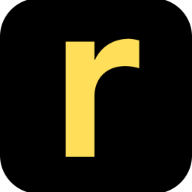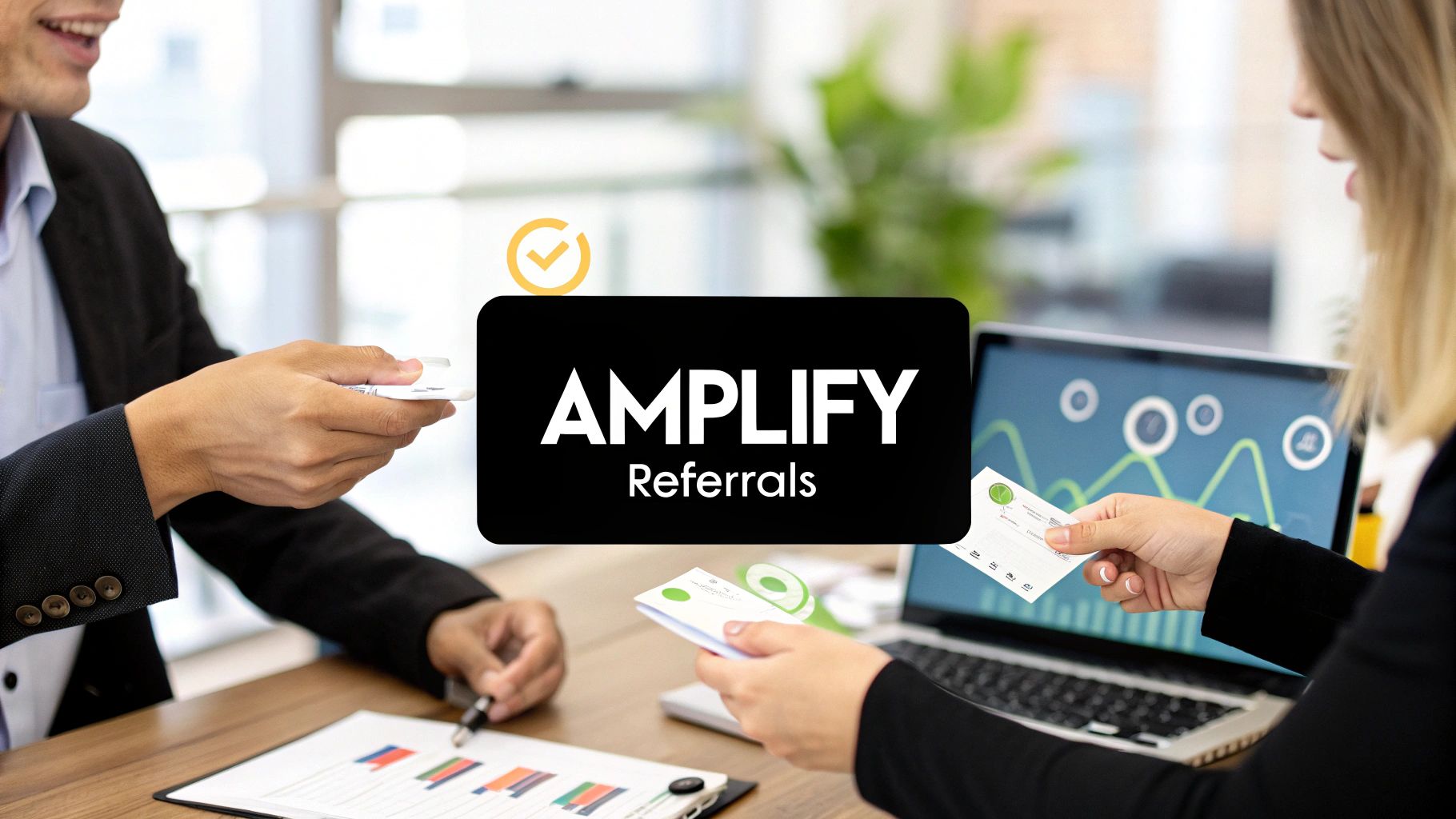What if you could turn your happiest customers into your most effective sales team? That's the magic behind a customer referral program. It’s essentially a structured system designed to reward your existing customers for bringing new people into the fold.
This isn't just about hoping for the best. It's about taking the powerful, organic force of word-of-mouth and turning it into a predictable, scalable growth channel for your business.

Turning Whispers into a Megaphone
Think of a referral program as a digital amplifier for word-of-mouth. People already talk about the products and services they love. A formal program just adds a little fuel to that fire, giving them a clear reason and a simple way to spread the word.
Instead of just crossing your fingers and hoping for a stray mention, you're building an intentional system that actively encourages sharing. You’re transforming a happy, quiet customer into a vocal advocate. By offering a compelling reward—like a discount, account credit, or even cash—you give them a concrete nudge to tell their friends.
For SaaS companies, this is gold. A recommendation from a friend cuts through the marketing noise like nothing else. It delivers leads who are already warmed up and far more likely to convert, stick around, and become loyal customers themselves.
Why Trust Is Your Most Valuable Marketing Asset
The whole system is built on a simple, powerful human truth: we trust our friends. A recommendation from someone you know carries more weight than any flashy ad ever could. The data on this is overwhelming.
Word-of-mouth is a beast, driving an estimated $6 trillion in annual global spending. And get this—a massive 92% of consumers say they trust recommendations from people they know above all other forms of advertising.
This isn't just a feel-good metric; it has a real impact on the bottom line. Companies that nail their referral strategy can boost their profitability by as much as 25%. If you want to dive deeper into the mechanics, this guide on referral marketing is a great place to start. When you build your marketing on a foundation of trust, you unlock one of the most efficient growth channels available.
The Immediate Business Payoff
When you compare a well-run referral program to traditional marketing, the advantages become crystal clear. It's a remarkably cost-effective way to bring in high-quality customers who tend to be more loyal and have a higher lifetime value.
To really see the benefits, let's break down the key advantages in a simple table.
Key Advantages of a Customer Referral Program
| Benefit | Impact on Business | Supporting Statistic |
|---|---|---|
| Lower Acquisition Cost | You spend less on paid ads because your customers are doing the marketing for you, dramatically improving your ROI. | Referred customers can cost 16% less to acquire than customers from other channels. |
| Higher-Quality Leads | Referrals show up with built-in trust from a friend, making them more receptive and easier to convert. | Referred customers have a 4x higher lifetime value than other customers. |
| Increased Customer Loyalty | Rewarding your customers for spreading the word deepens their connection to your brand and builds a stronger community. | Customers acquired through referrals have a 37% higher retention rate. |
| Sustainable Growth Engine | It creates a flywheel effect: new customers brought in by referrals are often more likely to refer others, creating a self-sustaining cycle of growth. | A 10% increase in word-of-mouth can translate to a sales increase between 0.2-1.5%. |
Ultimately, by putting a system in place to encourage and reward sharing, you can transform your customer base from a passive audience into a powerful, predictable engine for business growth.
The Compounding Power of Referred Customers
When a new customer signs up through your referral program, it's easy to see it as just another sale. But that's thinking too small. Think of it less like a one-off transaction and more like planting a tree. The initial acquisition is just the seed; the real value grows and compounds over time, strengthening your business from the roots up.
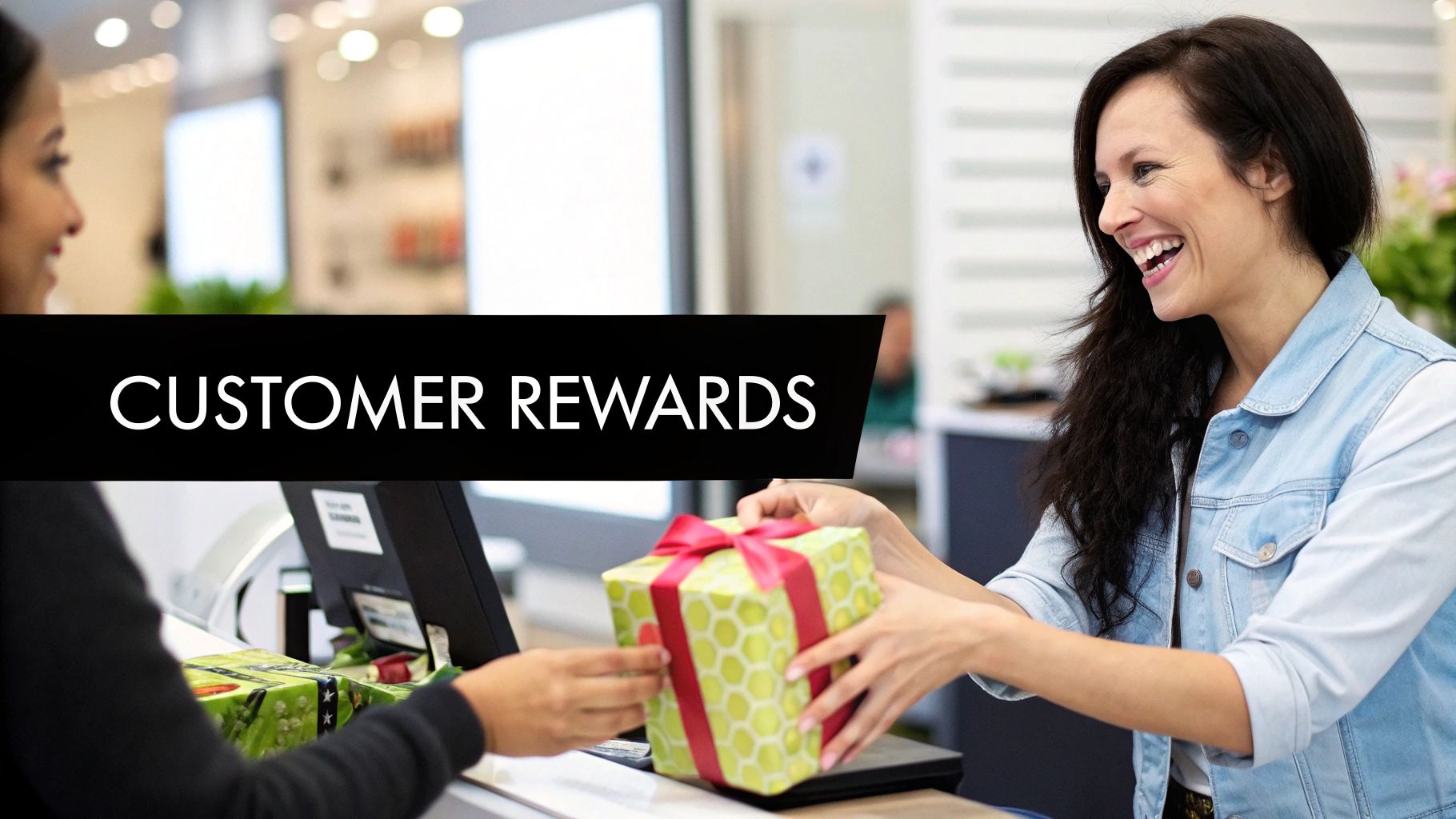
Unlike someone who clicks on an ad, a referred customer walks in the door with a powerful advantage: pre-existing trust. They aren’t starting from zero. They’re seeing your brand through the eyes of a friend who already vouched for you, which makes a world of difference in shortening the sales cycle and boosting conversions.
That initial trust doesn't just seal the deal. It lays the groundwork for a much stronger, longer-lasting relationship, which translates directly to a higher customer lifetime value (LTV).
The Viral Loop of Advocacy
Here's where the magic really happens: the "referral loop." This is the cycle where customers who were referred by someone else are far more likely to turn around and refer others. It’s a growth engine that fuels itself.
Picture it:
- Your happy customer, Alex, refers his friend, Ben. Alex gets a little something for his trouble, and Ben gets a nice welcome discount.
- Ben, just like Alex, has a fantastic experience. He was already expecting good things because of the recommendation.
- Now, Ben is much more inclined to pay it forward. He shares his own referral link with his colleague, Chloe.
- The cycle continues. Chloe signs up, and the potential for her to bring in even more people kicks off again.
This isn't just a nice theory; it's a proven multiplier for growth. Research from firms like McKinsey shows that word-of-mouth generates more than twice the sales of paid advertising. The compounding effect is undeniable: customers who come from referrals can bring in 30% to 57% more new customers than those from other channels.
A referred customer isn't just a new user; they are a potential new branch on your growth tree, capable of sprouting even more branches. This creates a sustainable, low-cost acquisition channel that strengthens with every new participant.
Lowering Costs and Building Loyalty
As this referral loop picks up speed, it has a massive impact on your bottom line. Your Customer Acquisition Cost (CAC) naturally drops because your existing customers are doing the marketing for you. Every referral is one less customer you have to pay for with expensive ad campaigns.
This builds a more profitable and resilient business. You're not just buying customers; you're building a community of advocates who are invested in your success. That kind of deep-seated loyalty is one of the most valuable assets you can have.
On top of that, these users often give more honest and helpful feedback because they feel like they’re part of the journey. That insight is gold for improving your product and the overall customer experience. You can find more strategies for encouraging this by checking out our guide on powerful referral marketing techniques. By focusing on the compounding power of referrals, you stop chasing short-term wins and start building a real, long-term competitive advantage.
Building Your High-Performing Referral Program
A great referral program doesn’t just pop up out of nowhere. It's a system you have to build with intention, designed to turn your happiest customers into a reliable stream of new business. To create one that really works, you can't just slap a discount code on your website and call it a day. It takes a thoughtful approach built on four key components that all have to work together.
Think of it like building a high-performance car. You need a powerful engine (The Offer), a sleek and easy-to-use body (The Experience), a full tank of gas (The Promotion), and a dashboard that gives you all the right info (The Tracking). If any one of those parts is weak, the whole machine will just sputter along, never hitting its true potential.
Pillar 1: The Offer
At its core, a referral program runs on the incentive. It’s the "what's in it for me?" that gets your customers to actually make a recommendation. The most effective offers are usually double-sided—this means both the person referring (your advocate) and their friend (the new customer) get something. This feels way more like giving a gift and less like a one-sided sales pitch.
Interestingly, one study found that non-cash incentives were 24% more effective than straight cash. This really drives home the power of offering value that’s directly tied to your own product.
When you're figuring out the reward, you generally have two main paths:
- Product Credits: For a SaaS company, this is often the best route. Offering account credits or a free month of service encourages people to use your product more and rewards your loyal users with something they already value.
- Cash or Gift Cards: These have universal appeal, but they can sometimes attract people who are just in it for the cash, not because they're bringing in genuinely good-fit customers. They work best for products with broad appeal—think of Casper's famous offer to "earn up to $75" via an Amazon gift card.
The goal is to craft an offer that feels generous but also makes sense for your brand. It should be an irresistible reason for your best customers to spread the word.
Pillar 2: The Experience
Even the most incredible offer won't work if the process for sharing is clunky and confusing. The referral experience has to be dead simple. Your customers are busy people; they aren’t going to jump through a bunch of hoops to send you a new customer. You want to make sharing feel like a natural, effortless part of using your product.
This means giving your advocates a unique referral link or code that’s easy to find, copy, and share wherever they want—email, social media, or a quick text message. For example, a tool like Refgrow lets you embed a referral dashboard right inside your own app. This makes the program feel like an integrated feature, not some tacked-on afterthought.
This infographic does a great job of showing how your program's goals should shape both your incentives and your promotion strategy.
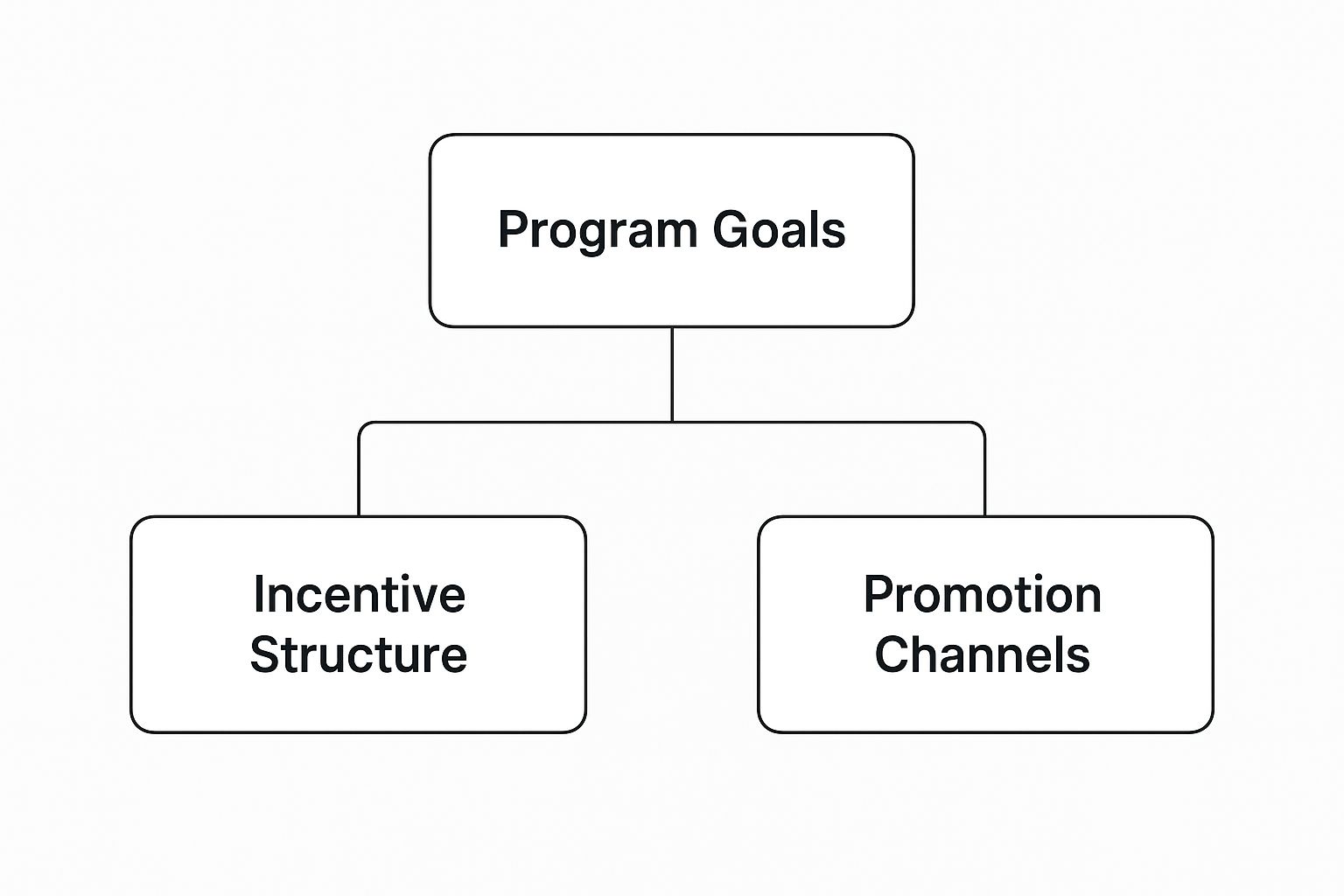
As you can see, when you're clear on your goals, it becomes much easier to choose the right rewards and promotional channels to build a cohesive plan.
Pillar 3: The Promotion
You could build the world's greatest referral program, but it's completely useless if no one knows it exists. Promotion is all about making sure your best customers see the program at just the right moments. Please, don't just hide a link in your website's footer and hope for the best.
Instead, you need to actively get the word out. Try a few of these channels:
- Email Campaigns: Send a dedicated email announcing the program to your most engaged users.
- In-App Notifications: Set up a pop-up or notification that triggers after a user accomplishes something positive, like completing a key task for the first time.
- Post-Purchase Pages: The moment right after someone buys from you is a point of peak customer happiness. It’s the perfect time to ask for a referral.
To get a better handle on turning your plans into real-world results, it's worth understanding the principles of effective marketing strategy implementation. A well-promoted program becomes an active part of your customer's journey, not a passive one.
Pillar 4: The Tracking
Finally, let's talk about something non-negotiable: accuracy. You absolutely must be able to attribute every single referral back to the right person, 100% of the time. This is all about building trust. If your advocates don't feel confident they'll get credit for their efforts, they'll stop trying. Shaky tracking is the quickest way to kill a program's credibility.
Modern referral software handles all of this automatically by tracking clicks, sign-ups, and conversions from unique referral links. This doesn't just guarantee advocates get their rewards on time; it also gives you priceless data on who your top promoters are and which channels are bringing you the best new customers.
For a complete walkthrough on putting all these pieces into action, check out our guide on https://refgrow.com/blog/building-a-referral-program.
Designing Incentives That Truly Motivate
Let's get one thing straight: the heart and soul of any referral program isn't the fancy software or the slick landing page. It's the incentive. A great reward is what turns a satisfied customer into someone who actively goes out and tells their friends about you.
But just throwing money at the problem rarely works. You've got to dig a little deeper and understand what actually makes people tick. It's really a balancing act between two kinds of motivation.
First, you have extrinsic rewards—the tangible stuff like cash, discounts, or account credits. They're simple and easy to grasp. Then there's intrinsic motivation, which speaks to deeper human needs: the desire to be helpful, gain a bit of status, or get access to something exclusive. The best referral programs masterfully weave both together.
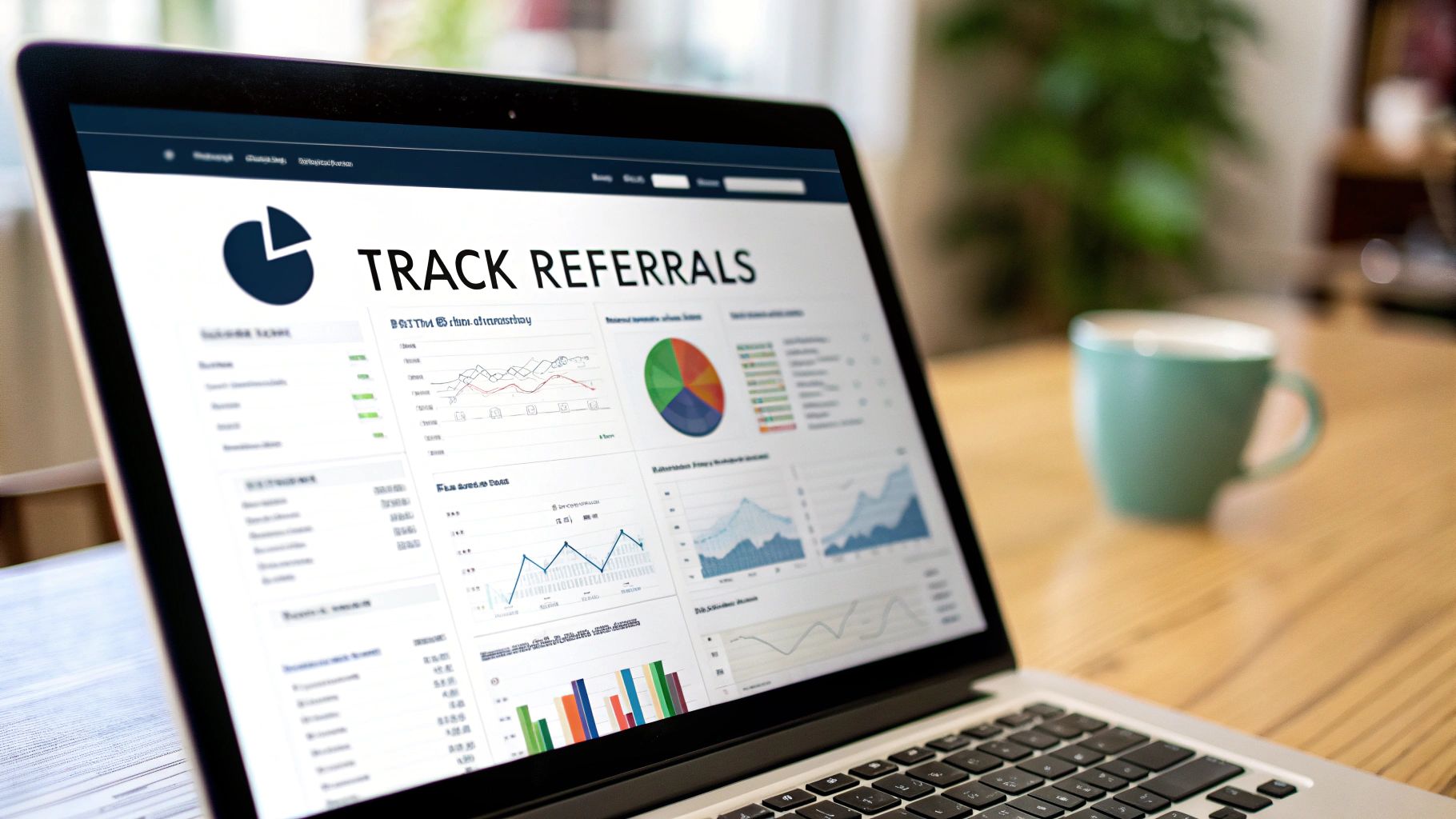
Beyond Simple Discounts: The Art of Reward Structures
Sure, a standard "give 10%, get 10%" offer is better than nothing. But if you want to create real excitement and keep people engaged, you need to get more creative with your reward structures. This is how you transform a simple offer into an experience that hooks your most passionate fans—your power-referrers.
Think about layering your incentives. This keeps advocates coming back for more. Here are a few structures I’ve seen work wonders:
- Tiered Bonuses: As advocates hit new referral milestones, the rewards get better. Their first referral might earn them a small credit, but their tenth could unlock a huge discount or a premium feature for free. It turns referring into a game and keeps them motivated.
- Milestone Achievements: Celebrate big numbers. When someone hits 25 successful referrals, give them a "Super Advocate" badge on their profile or send them some exclusive company swag. It’s about recognition, not just the reward itself.
- Gamified Leaderboards: If you have a competitive user base, a public leaderboard showcasing the top referrers can be a game-changer. Offering a big prize to the #1 spot each month or quarter can unleash a wave of high-quality leads.
A referred customer is one of your most valuable assets. Research shows that, on average, a customer acquired through a referral has a 16% higher lifetime value. This is why investing in motivating incentives pays such high dividends.
Choosing the Right Incentive for Your Business
The "perfect" incentive doesn't exist in a vacuum. It has everything to do with your product, your price point, and who your customers are. The reward for a high-ticket B2B SaaS tool should be worlds apart from a B2C mobile app.
For most SaaS companies, I’ve found that product-related rewards are king. Offering account credits or a free month of service is a brilliant one-two punch. It gives your user real value while simultaneously encouraging them to stick with your product longer. You're giving them more of what they already love, which reinforces their loyalty.
Cash rewards, on the other hand, can be a bit of a double-edged sword. They can sometimes attract low-quality referrals from people just trying to make a quick buck. But don't write them off completely—they can be incredibly effective for products with mass appeal where the value of a single new customer is sky-high.
The data backs this up. We consistently see that referral marketing delivers leads that convert 3 to 5 times higher than other channels. And if you want to know where things are headed, you can read up on referral marketing statistics that show gamification and experiential rewards becoming even more important.
In the end, your goal is to land on a reward that feels generous to your advocate and genuinely valuable to the new customer they’re bringing in. Get that right, and you’re golden.
How to Promote Your Referral Program for Maximum Impact
Building a killer referral program is a fantastic start, but it’s only half the job. If your customers don’t even know the program exists, it might as well be invisible. The real trick is promotion—this is what separates a program that quietly fades away from one that becomes a genuine growth engine for your business.
Forget about thinking of promotion as a one-time blast or a single announcement. The secret is to weave your referral program directly into the fabric of the customer journey. It shouldn't be some forgotten link buried in your website's footer. It needs to be a visible, valuable part of their entire experience with your brand.
This means getting smart about when and where you ask for a referral. You want to catch your customers right in those moments of peak happiness—when they're feeling great about your product and are most excited to tell their network about it.
Make Your Program Unmissable
Visibility is everything. Your advocates shouldn't have to hunt for their referral link. Making it incredibly easy to find and share is the first step toward getting any real momentum. A platform like Refgrow makes this simple by letting you embed a referral dashboard right inside your SaaS app, so it feels like a native part of the user experience.
Here’s a great example of how a program can be presented on a website in a way that's both clear and appealing.
This layout gets straight to the point. It instantly shows the main benefit—earning commissions—and provides a big, obvious button to get started.
When you integrate the program this deeply, it becomes a consistent and accessible feature, not just another promotional campaign that people will ignore. That constant visibility keeps the idea of referring friends top-of-mind for your most loyal users.
Identify and Leverage "Moments of Delight"
Timing your ask is absolutely crucial. Ask at the wrong time, and it feels pushy or awkward. But ask at the right time, and it feels like a completely natural next step. The key is to pinpoint those "moments of delight" along your customer's journey.
These are the high points where they've just had a win or felt the true value of your product.
- After a great customer support interaction: Your team just solved a customer's problem and they're feeling relieved and grateful. A simple, "Glad we could help! By the way, did you know you can get credit for sharing us with a friend?" can work wonders.
- Right after a purchase or upgrade: The "thank you" page is prime real estate. The customer is feeling good about their decision, making it the perfect time to suggest they share that excitement.
- When a user hits a key milestone: Did they just export their first big report, complete a major project, or reach a usage goal? Celebrate that win with them via an in-app notification that also casually mentions the referral program.
Use Multiple Channels for Promotion
Don't put all your eggs in one basket. Relying on a single channel to promote your program is a surefire way to get low engagement. A multi-channel approach is the only way to make sure you're reaching customers where they actually hang out.
A fascinating study found that non-cash incentives were 24% more effective than cash rewards. This really shows the power of offering value tied directly to your product—like account credits or free upgrades—which you can then promote across all your different channels.
A well-rounded strategy should mix and match several of these touchpoints:
- Targeted Email Campaigns: Don't just email your entire list. Segment your most active and loyal users and send them a dedicated email. Make them feel like they're being invited to an exclusive club.
- In-App Messages and Banners: Use subtle, non-annoying banners or pop-ups inside your application to keep the referral program on your users' radar.
- Social Media Shout-Outs: Every so often, remind your social media followers that the program exists. You can even feature your top advocates to add a layer of social proof and friendly competition.
- Newsletter Mentions: Add a permanent, eye-catching section to your regular customer newsletter that spells out the benefits of joining the referral program.
By consistently promoting your customer referral programs across these different channels, you create a system where your best users are frequently and gently reminded of the value they can get just by spreading the word. For even more ideas, check out our in-depth guide to building a complete referral program marketing strategy.
Of course. Here is the rewritten section, designed to sound like an experienced human expert and meet all the specified requirements.
Common Questions About Customer Referral Programs
So, you've got the basic concept down. But let's be honest, the real questions pop up when you start to put a plan into action. Theory is one thing, but navigating the real-world bumps and "what-if" scenarios is another game entirely. Think of this as your field guide for those common hurdles.
We're going to tackle the stuff that keeps founders and marketers up at night—from nailing the timing of your launch to keeping your program safe from people trying to game the system. My goal here is to give you the confidence to not just build a referral program, but to run a great one.
When Is the Right Time to Launch a Referral Program?
This is probably the number one question I get. Should you have a referral program ready on day one, or is it better to wait until you have a bigger user base? There’s no single right answer, but there are definitely clear signs that you’re ready.
Before you do anything else, you need a product that people genuinely love. A referral program is just an amplifier; it can't fix a product that isn't solving a real problem. You need a core group of happy customers—the kind of people who would probably recommend you anyway, even without a reward.
Keep an eye out for these signals:
- Positive Customer Feedback: Are people reaching out with unsolicited praise? Seeing positive mentions on social media or glowing reviews? That's your first clue.
- High Customer Satisfaction Scores: Metrics like your Net Promoter Score (NPS) are invaluable here. If you have a solid number of "Promoters" (people scoring you a 9 or 10), you've already got a built-in referral army waiting.
- Healthy Retention Rates: If customers are sticking around month after month, you know they're getting real value. These loyal, long-term users are the perfect candidates to become your best advocates.
If you launch too early, you'll just hear crickets. But if you wait too long, you're leaving a massive, low-cost growth channel on the table. The sweet spot is right when you have clear, undeniable proof of customer love.
How Can We Prevent Referral Fraud?
Unfortunately, the minute you offer a reward, you also invite people to try and cheat the system. It can be as simple as someone referring themselves with a different email or as complex as a more organized scheme. Protecting your budget and the integrity of your program has to be a priority from the start.
Don't worry, you don't need to build Fort Knox. A few smart, simple safeguards can deter most of the trouble. The idea is to make fraud more work than it's worth.
Here are a few proven anti-fraud measures:
- Require a Successful Conversion: This is a big one. Don't reward the advocate for a simple sign-up. The reward should only kick in after the new person takes a meaningful action, like making their first payment or staying active for 30 days.
- Verify New Users: A simple email verification or requiring a valid payment method goes a long way in ensuring the referred user is a real, unique person.
- Set Clear Terms and Conditions: Your program rules need to explicitly ban self-referrals and other shenanigans. This gives you the ground to stand on if you need to deny a reward or ban a user.
- Monitor for Suspicious Patterns: Be on the lookout for red flags. Is one IP address suddenly generating dozens of referrals? Are you seeing a ton of referrals that never convert to paid accounts? Good referral software, like Refgrow, often has this monitoring built-in.
Fraud prevention isn't about being cynical; it's about being strategic. By building a few simple checks into your system, you ensure that your rewards go to genuine advocates who are bringing real, valuable customers to your business.
Should We Offer Cash or Product Credits?
The "cash vs. credits" debate is a classic, and choosing your incentive is a huge decision. Both can work, but they encourage different behaviors and fit different business models.
For most SaaS companies, product credits—like a free month or a discount on the next bill—are almost always the better choice. Why? Because they're tied directly to your product. This means they mostly appeal to loyal customers who already love what you do and want more of it. It creates a fantastic feedback loop: you reward your best users with more of your service, which makes them even more loyal.
Cash rewards (or gift cards) are universally appealing and can be a powerful motivator. The downside is that they can attract "bounty hunters"—people who are only in it for the money and might not send you the best-fit customers. Cash tends to work best for products with a very high lifetime value or for consumer-facing brands trying to get massive, rapid adoption.
To help you sort it out, here’s a quick breakdown.
Referral Program Reward Structures
Choosing the right reward isn't just about what you can afford; it's about what will motivate your specific customer base and align with your business goals. This table compares the two most common options to help you decide which path makes sense for you.
| Reward Type | Best For | Pros | Cons |
|---|---|---|---|
| Product Credits | SaaS, subscription services, and businesses with a loyal user base. | Encourages product usage and deepens loyalty. More cost-effective as the value is delivered within your ecosystem. | Less appealing to advocates who may not need more service at that moment. |
| Cash Rewards | B2C products, high-ticket items, and programs focused on rapid scaling. | Universally motivating and easy to understand. Can generate a high volume of initial interest. | Can attract low-quality leads and fraudulent behavior. Less effective at building brand loyalty. |
Interestingly, some research shows that non-cash incentives can be up to 24% more effective than cash. The reason is psychological. A product credit feels like a genuine "thank you" from a brand you already like, whereas a cash payment can feel purely transactional.
Ready to turn your best customers into your most powerful growth engine? With Refgrow, you can launch a fully native referral program directly inside your SaaS application in minutes. Stop wrestling with clunky external tools and start building a seamless, branded experience that drives real results. Explore how Refgrow can accelerate your growth today.
